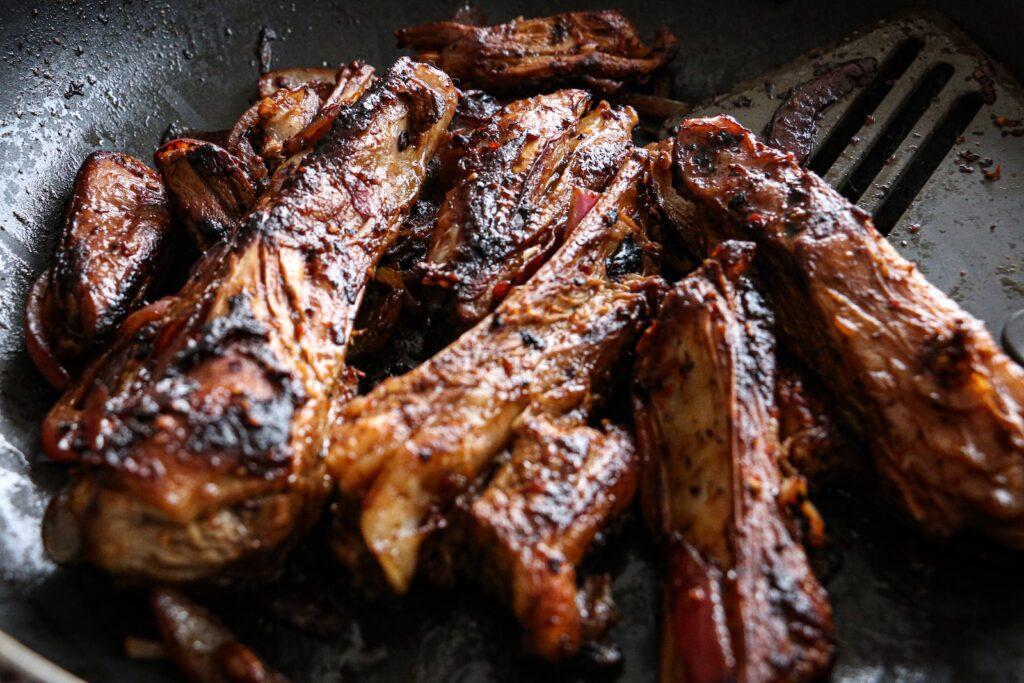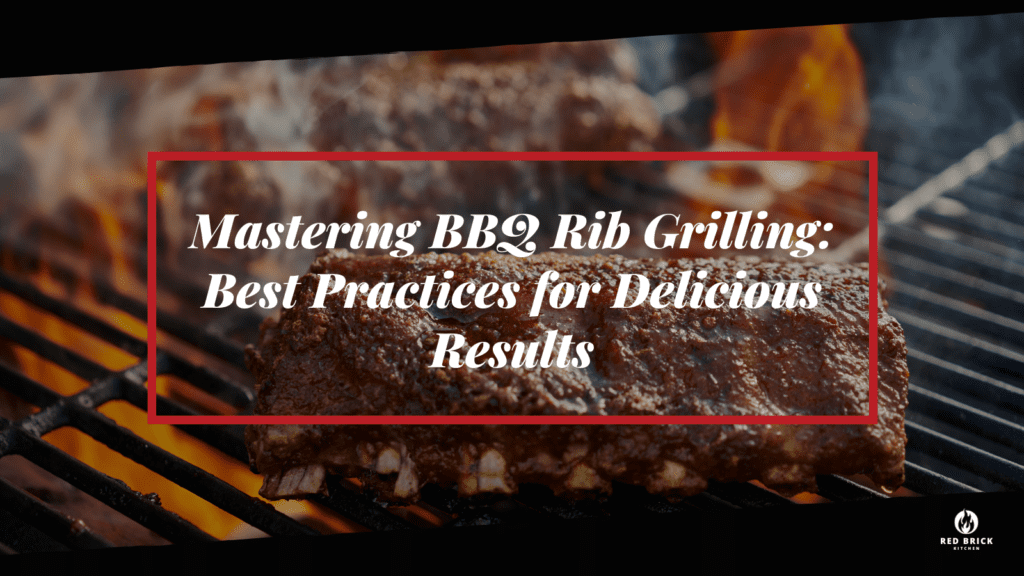Barbecue ribs are an enduring culinary classic, cherished for their delectable and tender meat, traditionally prepared from pork or beef. Grilling or smoking ribs is a time-honored method that imbues them with mouthwatering flavors. Whether you’re hosting a summer barbecue or craving a hearty meal, mastering the art of BBQ rib grilling is essential. In this guide, we’ll explore best practices for selecting the right grill, achieving the perfect temperature, cooking times, and additional tips and tricks to elevate your rib-grilling game.
Types of Ribs
Before diving into grilling techniques, it’s important to familiarize yourself with the different rib cuts available:
- Baby Back Ribs: These ribs, taken from the top of the rib cage, are celebrated for their tenderness and lean meat. Their smaller size makes them ideal for those with lighter appetites.
- Spare Ribs: Cut from the lower part of the rib cage, spare ribs are rich in meat and fat, offering a robust and indulgent flavor.
- St. Louis-Style Ribs: These are spare ribs that have been expertly trimmed to remove the breastbone and cartilage. With a uniform shape and even cooking, they are a preferred choice among BBQ enthusiasts.
Selecting the Right Grill
Choosing the right grill is pivotal for grilling ribs to perfection. Consider the following grill types:
- Charcoal Grill: Renowned for their intense heat and smoky flavors, charcoal grills require charcoal briquettes or lump charcoal as fuel.
- Gas Grill: Gas grills offer convenience with push-button ignition and precise temperature control, making them an excellent choice for beginners.
- Smoker: Designed specifically for slow cooking and smoking meats, smokers deliver an authentic smoky flavor and tender texture to ribs.

Factors to Consider When Buying a Grill
When purchasing a grill for ribs, keep these key factors in mind:
- Size: Ensure the grill can accommodate the number of ribs you plan to cook.
- Heat Distribution: Opt for grills with even heat distribution to ensure uniform cooking.
- Temperature Control: Select grills with adjustable temperature settings for precise control.
- Build Quality: Choose grills made from durable materials capable of withstanding high temperatures and frequent use.
Temperature Considerations
Achieving the perfect temperature is paramount when grilling ribs.
The Ideal Temperature: To yield tender, juicy ribs with a beautiful exterior, grill them at a temperature of around 225-250°F (107-121°C). This low and slow method allows connective tissues to break down, resulting in melt-in-your-mouth goodness.
Setting Temperatures: Grill temperature settings vary depending on the grill type. For gas grills, preheat on medium heat and create an indirect cooking zone. For charcoal grills, use ashed-over coals, a drip pan, and regulate temperature via vent adjustments.
Cooking Times
While cooking times may vary based on factors such as grill temperature, rib thickness, and personal preference, here are general guidelines:
- Spare Ribs: Typically take around 3-4 hours.
- Baby Back Ribs: Usually require approximately 2-3 hours.
Determining Doneness
Knowing when your ribs are perfectly cooked is essential. Consider these methods:
- Checking Color: Well-cooked ribs will exhibit a caramelized crust with a rich brown color, adding depth to flavor and texture.
- Using a Meat Thermometer: A precise way to gauge doneness, spare ribs should reach 195-203°F (90-95°C), while baby back ribs should reach 190-205°F (88-96°C). Insert the thermometer into the thickest part of the meat, avoiding the bone.
Tips and Tricks
To elevate your rib-grilling experience, consider these expert tips:
Brining: Enhance flavor and tenderness by brining ribs in a mixture of water, salt, sugar, and spices for several hours or overnight.
Basting: Brush ribs with a flavorful sauce during grilling to enhance taste, moisture, and develop a smoky glaze.
Serving Ribs
Pair your perfectly grilled ribs with complementary side dishes and sauces:
Complementary Side Dishes:
- Coleslaw: A refreshing and crunchy choice that complements the richness of BBQ ribs.
- Cornbread: A sweet and savory southern classic with a crumbly texture.
- Baked Beans: Thick, smoky, and rich, baked beans are a traditional BBQ side dish.
- Grilled Vegetables: Add color and freshness with bell peppers, zucchini, and corn on the cob seasoned and grilled alongside the ribs.
Great Sauces for BBQ Ribs:
- Classic BBQ Sauce: A tangy, slightly sweet sauce that enhances rib flavor.
- Spicy BBQ Sauce: Adds a fiery kick for those who enjoy heat.
- Mustard-Based Sauce: Tangy and zesty, providing a unique flavor profile.
- Fruit-Based Sauce: Adds sweetness with flavors like mango, pineapple, or apple.
Conclusion
With these best practices, you’re well-equipped to grill the perfect BBQ ribs every time. From selecting the right grill to controlling temperature and cook times, you can create ribs that are tender, juicy, and full of flavor. Experiment with brine recipes, basting sauces, and side dish combinations to find your ideal BBQ rib experience. Enjoy the delectable aromas and mouthwatering flavors of perfectly grilled ribs.
Additional Resources
Recommended Products:
- High-quality barbecue grills
- Digital meat thermometer
- Basting brush
- Rib rack for easy grilling
Cookbooks and Online Resources:
- “BBQ Ribs: Recipes and Techniques” by Steven Raichlen
- “Weber’s Big Book of Grilling” by Jamie Purviance
- Online recipes and websites dedicated to BBQ and grilling techniques, such as BBQ Pit Boys and Serious Eats BBQ section
FAQs for Delicious BBQ Rib Grilling
What grills are best for cooking ribs?
There are various types of grills that work well for cooking ribs, including charcoal grills, gas grills, and smokers. Ultimately, the best grill for cooking ribs depends on personal preference and the desired flavor profile.
What should I look for when buying a grill?
When buying a grill for cooking ribs, consider factors such as size, fuel type, heat control, and additional features like built-in thermometers or side burners. It’s also important to consider durability and quality.
What are the different cuts of ribs?
The main types of ribs commonly used for BBQ are baby back ribs, spare ribs, and St. Louis-style ribs. Baby back ribs are smaller and more tender, spare ribs are larger with more meat, and St. Louis-style ribs are spare ribs trimmed to a rectangular shape.
How do I prepare ribs for grilling?
Before grilling, it’s essential to remove the thin membrane on the bone side of the ribs and season them with a dry rub or marinade. This helps to enhance the flavor and tenderness of the ribs.
What is the perfect temperature for grilling ribs?
The ideal temperature for grilling ribs is around 225°F to 250°F (107°C to 121°C). This low and slow cooking method allows the ribs to become tender and juicy while developing a smoky flavor.
How do I set temperatures for grilling ribs?
To achieve the desired temperature, preheat your grill and adjust the vents or burners accordingly. Use a reliable meat thermometer to monitor the grill’s temperature throughout the cooking process.
What time should I start grilling ribs?
It’s recommended to start grilling ribs at least 4 to 6 hours before you plan to serve them. This allows enough time for the ribs to cook slowly at a low temperature and become tender.
How long do I cook ribs on the grill?
The cooking time for ribs on the grill can vary depending on factors such as the grill temperature, rib thickness, and personal preference. On average, it takes around 3 to 4 hours for ribs to cook thoroughly on a grill.
How can I check the doneness of ribs by their color?
When cooking ribs, they should have a beautiful caramelized exterior and a rich reddish-brown color. The meat should also start pulling away from the bones slightly, indicating that they are ready to be taken off the grill.
Can I use a meat thermometer to check if the ribs are done?
Yes, using a meat thermometer is a reliable method to determine if the ribs are cooked to perfection. Insert the thermometer probe into the thickest part of the meat, away from the bone. The internal temperature should reach around 195°F to 203°F (90°C to 95°C) for tender and juicy ribs.
What is brining, and how does it enhance the flavor of ribs?
Brining involves soaking the ribs in a saltwater solution before grilling. This process helps to improve moisture retention, enhance tenderness, and infuse flavors into the meat. It can be done by combining water, salt, sugar, and desired spices in a brining container.
What is basting and why is it beneficial for cooking ribs?
Basting involves regularly applying a sauce or marinade to the ribs during the grilling process. This enhances the flavor, keeps the ribs moist, and creates a caramelized glaze on the surface. Brush the sauce on the ribs during the last 30 minutes of grilling, allowing it to develop a delicious coating.
What are some complementary side dishes to serve with ribs?
Popular side dishes to serve with ribs include coleslaw, baked beans, macaroni and cheese, cornbread, potato salad, grilled vegetables, and fresh salads. These options complement the smoky and savory flavors of the ribs.
What types of sauces can I serve with ribs?
Ribs can be enjoyed with various types of sauces, including barbecue sauce (such as Kansas City, Memphis, or Carolina style), honey glaze, spicy Sriracha sauce, and tangy mustard-based sauce. The choice of sauce depends on personal preference and regional BBQ traditions.
How can I ensure I enjoy the perfect ribs?
To ensure you enjoy the perfect ribs, follow the cooking instructions carefully, monitor the grill temperature, and use a meat thermometer to check for doneness. Allow the cooked ribs to rest for a few minutes before slicing and serving to retain their juiciness.
What should I look for when cooking ribs?
When cooking ribs, it’s important to look for a beautiful golden crust, tender meat that pulls away from the bone, and a smoky aroma. The ribs should be juicy and flavorful, with the desired level of caramelization and seasoning.
Last updated: September 25, 2023


